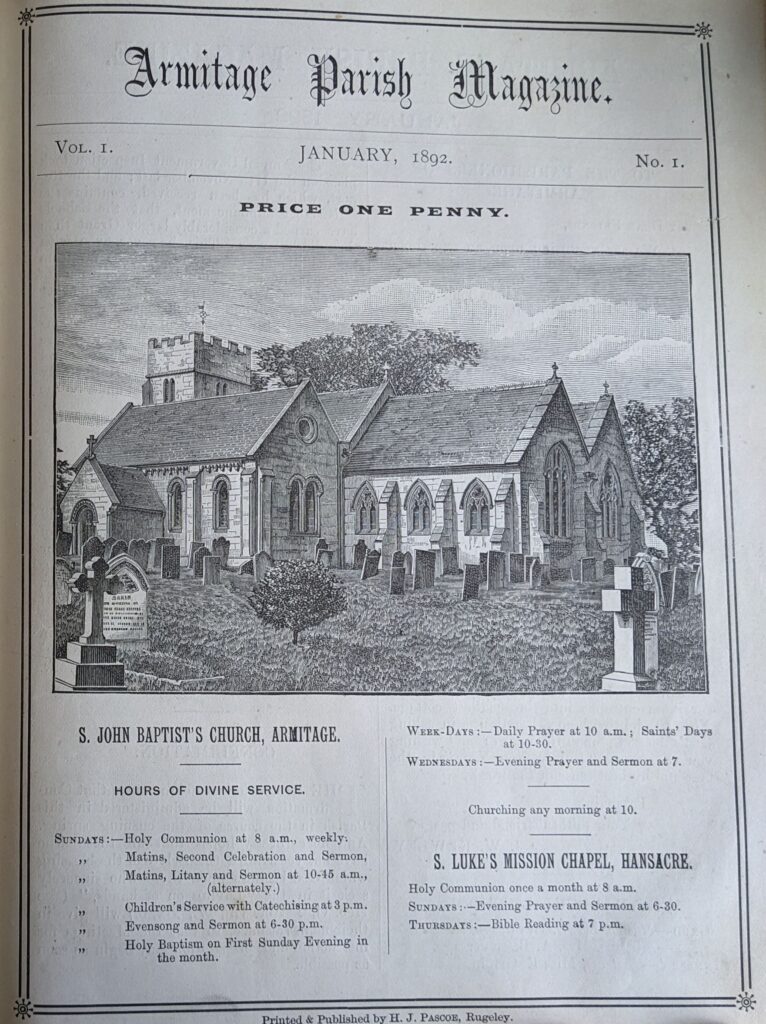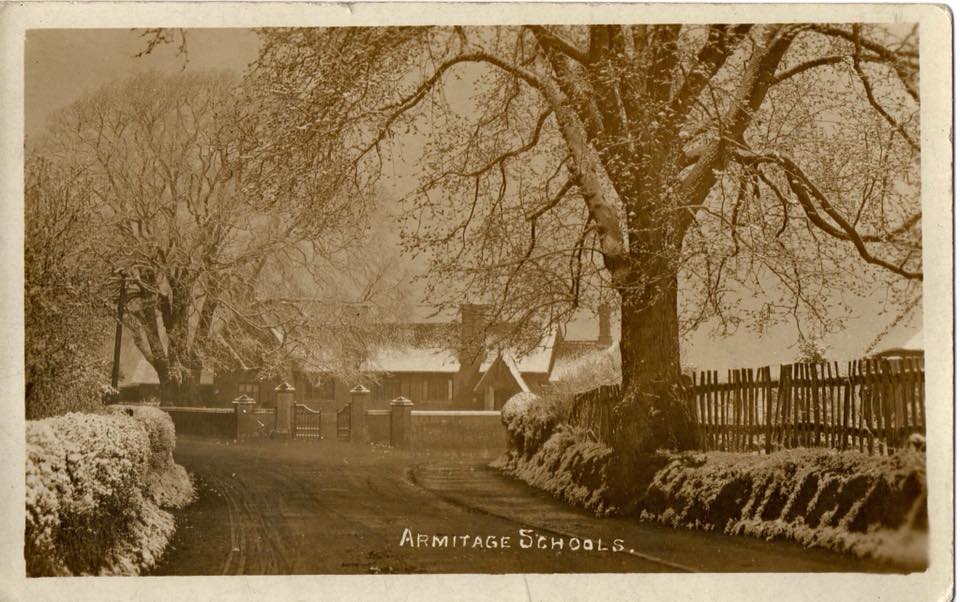The very first edition of Armitage parish magazine came out in January 1892,priced one penny. The rendition of the church on the front cover, shown below, is stated as being a woodcut owned by Miss Birch, of Armitage Lodge, and is from a photograph taken by Mr. H. Cecil Gardner, of The Towers. The parish at that time was just known as Armitage but there was a C of E chapel (St. Luke’s) in Hansacre i.e. without the ‘d’.

The magazine was one sheet of paper printed on both pages then folded in the middle to give four pages. It was obtainable from the Post Office or, for those who lived at Handsacre, from Mr. Wm. Kent’s in Lichfield Road.
On the front cover were the hours of service and a note stating there was daily prayer on every weekday morning as well as churching. The first section read as follows: –
TO THE PARISHIONERS OF ARMITAGE.
MY DEAR FRIENDS,
We are venturing upon an experiment, the success of which will entirely depend upon your hearty assistance in carrying out the object we have in view. It has long been my desire to see a Monthly Parish Magazine established, and in general circulation among us, but the difficulties, which year after year presented themselves, have been such as to deter me from undertaking what would be likely to demand more time than I would conveniently bestow upon it, and to involve the risk of more expense than it would be right for me to incur. At last, however, through the kindness of valued helpers, the way seems to be open for making the attempt; and now in the beginning of New Year, to which God has mercifully spared us, I commend to you the first issue of The Armitage Parish Magazine, with the fervent hope that it will be widely welcomed, and so prove a useful auxiliary to our Parochial Work. The Magazine, as you may see, will be a record of matters of purely local interest, as well as a source of general entertainment, instruction, and religious edification; and while its contents will, I trust, be of such a character as to render it acceptable to the dwellers in the larger houses of the Parish, its cost will be sufficiently low to gain for it an entrance into the smallest cottage. You will join me, I am sure, in asking God’s blessing upon this effort; and wishing you all a very “Happy New Year” in the best and highest sense of the words,
I remain,
Your faithful friend and pastor,
J. W. KEWLEY
The village school at that time, shown below, had been built at the top of Church Lane in 1839 on land owned by the then rector of Armitage, Rev. Francis Wilson, and set up by the Church as a National School. This meant that it was for both boys and girls and to be used to provide for the education of the poor in the principles of the Established Church. The rector was responsible for the religious and moral training of the scholars. Until 1870 all schools were charitable or private institutions but the 1870 School Act enabled Local Authorities to provide schools. The school therefore recruited a certificated schoolmaster and it became a Denominational School, supported by voluntary subscription, which meant that the Governors could choose the religious curriculum. By 1892 free education had been introduced by the Government and the second item in the magazine stated that more voluntary subscription was urgently needed. Magazine recipients were urged to become monthly, quarterly, half-yearly or annual subscribers to the school Fund.

The magazine contained a report headed ENTERTAINMENT which reported on a programme given in the ‘Large Schoolroom’ on Friday 18th December by the Shakesperian (sic) Class which had recently been formed by Mr. Lyversage, the school headmaster. Proceeds for that evening went to the School Fund.
Another section was headed ‘Church of England Temperance Society’ which was often found in later magazines and in the newspapers abbreviated as C.E.T.S. It was an appeal to revive an interest in Temperance and promoted a Lecture to be given in the large schoolroom on 19th January by Mr. A. C. Cartlidge. He would be presenting a lecture, illustrated by Magic Lantern representations, and it would consist of three parts:-
- Which side wins? Or the Life of Jim Fergus
- Humourous (sic) Varieties
- Billy’s Rose.
The third item is a 20+ verse poem written by George R. Sims (1847 – 1922) in which Billy is a dying child on the city streets and his sister Nell tells him stories of the Promised Land and he tells her of his wish for a rose. They were on the streets because of a drunken father’s curses and a drunken mother’s blows. Later editions of the magazine cover the Band of Hope which was a movement for children to make the pledge of temperance.
The magazine also had sections on bible reading at St. Luke’s Chapel, Christmas Day attendance, burials during December (there were no baptisms or marriages in December 1891) and the offertories collected during December 1891.
The back page carried adverts from John Biddle, a grocer in Rugeley, and Key’s Clothing shop, also in Rugeley. A quarter of the back page is shown below – there hadn’t been enough time to get another sponsor willing to support the magazine. Future editions eventually had another advert.

Later editions of the magazine in the 1890s often reported on the school and Mr. Lyversage and covered items such as the cricket and football club, and the newly formed cycling club called ABC (Armitage Bicycling Club).
